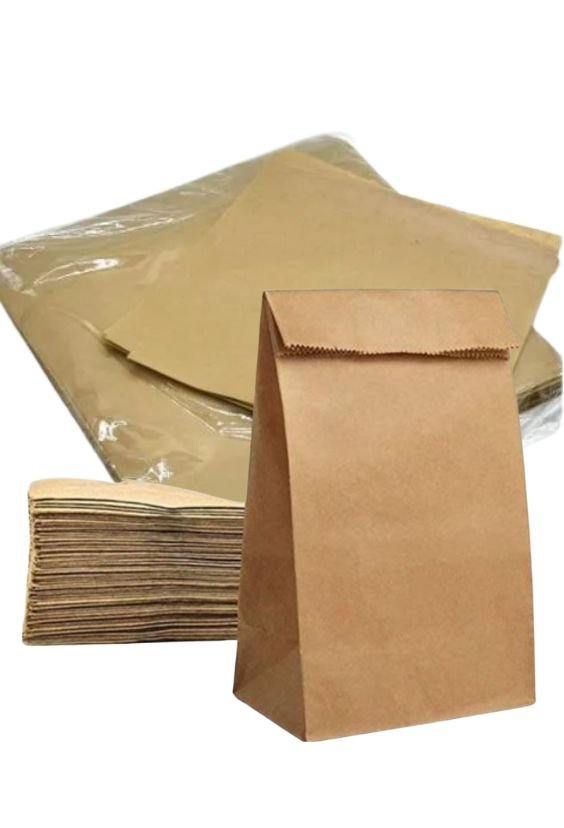Food Packaging

Food Packaging
Kraft paper has emerged as a top choice for food packaging due to its natural strength, durability, and eco-friendly properties. Made from wood pulp using the kraft process, this paper is biodegradable, recyclable, and safe for direct food contact. It provides excellent protection for a variety of food items, ensuring freshness and preventing contamination while maintaining sustainability. Kraft paper’s versatility allows for various applications in the food industry, from takeout bags and food wraps to tray liners and packaging for dry goods. As the demand for sustainable packaging grows, kraft paper offers an ideal solution for businesses aiming to reduce their environmental impact while ensuring product safety.
Product Details:
| GSM Range | 28 Onwards |
| BF Range | 18 - 40 BF |
| Shade | Bleached, Unbleached |
| Moisture | 6% |
| Brightness | As per requirement |
| End Use | Food Bags, Carry Bags, Wrapping |
- Features of Food Packaging Paper
- Applications of Food Packaging Paper
- Contact Us
Food packaging works to keep, protect, and market foodstuffs. The basic functions of food packaging are protecting the product from dangers that could cause harm to the consumer, extend its shelf life, and enhance the overall experience of the consumer. Some of the main functions of food packaging include the following:
1. Barrier Protection
Moisture Barrier: Great food packaging also acts as an obstacle against water as this prevents food from losing moisture or gaining too much water that would spoil it or deteriorate.
Oxygen Barrier: Such packaging materials control the entry of oxygen into the food, thus keeping freshness, color, and flavor inside the foods, especially with vacuum packaging or modified atmosphere packaging, or MAP.
Light Barrier: Products like oils, dairy, or beverages in a food package may be blocked or filtered by light to prevent oxidation or spoilage from UV rays.
Odor Barrier: Packaging is used to prevent odors from the external environment entering the food or to retain the odor generated within the food.
2. Durability and Strength
Mechanical Protection: Food packaging is used to offer physical protection against damage during transportation and handling of foods, especially to fragile products.
Crush and Impact Resistance: Many food packaging types, including rigid boxes, cans, and different types of cartons are made with resistance to crushing so that contents are not affected.
Rip and Tear Resistance: Plastics, laminates, and foils show a high resistance to ripping and tearing, hence rendering food unadulterated by contamination.
3. Food Safety and Sanitation
Non-Toxic and Food-Grade Materials: Food packaging materials are nontoxic and free of chemicals to prevent contamination by harmful substances of the food inside.
Compliance to Regulations : Food packaging has to follow several standards of safety and health that regulatory instituted bodies like the FDA, EU, among others have indicated. This is to ensure that food packing can safely contact the food without affecting it
4. Preservation and Shelf Life Extension
Hermetic and airtight features: vacuum sealing, heat sealing, or snap lids seal out air, bacteria, and other contaminants to maximize product shelf life.
Modified atmosphere: some packaging features employ a modified atmosphere with gas such as nitrogen in place of oxygen to extend food freshness for longer periods, similar to snack bags or ready-to-eat salads.
5. Convenience
Easy to Open Packaging has features that may be easily opened, including tear strips, peel back lids, resealable zippers, or pop-top lids.
Portability: Food packaging is designed to be very lightweight, easy to carry, and so pleasantly easy to fit into the more energetic consumer’s day. This is more typical for snack packaging, beverages and ready-to-eat food.
Portion Control: Food packages, especially that of snack foods and drink, are single-serving or portion-controlled. This way, consumers get the right amount of food, and there is less waste.
6. Sustainability and Eco-Friendliness
Recyclability: The proportion of food packaging material that can be recycled, with the consumer being encouraged to do so, promotes sustainability and reduces a bad environmental impact.
Biodegradable and Compostable Alternatives: Some of the food packaging is plant-based plastic, or it may be paper-based. These materials are either biodegradable or compostable and meet what consumers may actually look for when getting sustainably sourced food.
Lightweight Packaging: Brands can literally go as minimalist or lightweight as possible to reduce their waste material usage, making a difference in their minimization of harm to the environment.
7. Clear Labeling and Branding
Product Information Display: Packaging materials convey the following key product information clearly and understandably: nutritional facts, ingredients, expiration dates, and storage instructions. It provides information to consumers and meets food labeling requirements.
Brand Identity: Packaging is used as a type of canvas, which appeals to customers using logos, colors, and design features to promote the image, quality, or values of a product, such as organic, vegan, or gluten-free.
Transparency: Most packages, especially for fresh or high-quality products, have transparent windows or are constructed of clear materials that would allow consumers to view the food before they bought it.
8. Temperature Resistance
Heat Resistance: Some packaging for food has been designed with an incredibly high temperature endurance, meaning that even when the product is being microwaved or oven-heated, it will not melt or leach dangerous chemicals.
Cold Resistance: Packaging for frozen foods are typically manufactured to endure freezing without becoming brittle or degraded. This will ensure food qualities remain in place even at deep freeze.
9. Tamper Evidence
Tamper Evident Seals: Food packaging solutions are primarily fitted with tamper-evident seals or closures, such as safety bands, vacuum indicators, breakable tabs, to provide assurance to the consumers that the product has not been tampered with or contaminated.
Child-Proof Features: In many packaging for specific products-these drugs, vitamins, or hazardous materials -can be child-resistant to prevent unintended opening of the said products.
10. Insulation
Temperature Control: Packaging can be made insulated on some products so that it maintains a certain temperature when on movement. Such products include frozen foods, ice creams, fresh temperature-sensitive products.
Some packs will also be done with thermal insulation, such as styrofoam or insulated bags, that will keep the food hot or cold when ready to be fresh and safe longer.
11. Cost-effectiveness
The available affordable materials constitute selecting food packaging in ensuring that the choice is well-balanced between cost and performance. Such materials include plastic, paperboard, and aluminum materials, which are even more economical for mass production and will ensure affordability not only to the manufacturers but also the consumers.
Efficient Manufacturing: Packaging is engineered to be mass-produced, ensuring lowest costs of production with no loss in quality and functionality.
12. Anti-microbial/Anti-fungal
Preserving Freshness: Some foods are packaged with anti-microbial or anti-fungal coatings or agents that prevent bacterial, mold, and other forms of contamination for longer shelf life and food safety.
13. Flexible and Rigid Options
Flexible Packaging: Pouches, bags, or wraps, that have a flexible shape, are very convenient for storage and transportation. It tends to be used for snacks, frozen vegetables, or sauces.
Rigid Packaging: If the product has to be adequately protected, there are rigid packaging such as cans, bottles, or boxes that provide structural support and maintain integrity.
14. Customizable Shapes and Sizes
Different Shapes: Packaging of food products comes in a variety ranging from a small pouch for snack portions to large container bulk for other products.
Shaped Designing: Some packing shapes have innovatively been designed to add an appeal to the product or to be used as multi-tasking tool. For instance, ready meals are found to come in a compartmentalized tray, and special beverage bottle shapes.
15. Multi-Functionality
Combination Packaging: In certain forms of food packaging, two or more kinds of containers are combined, such as a tray where the lid is attached and a snack pack wherein there are separated sections for dipping sauces.
Microwavable or Oven-Ready: Some packaging material has been made safe to be used directly inside the microwave or oven for the user’s convenience.
With its versatility, eco-friendliness, and delivery of safe, protective, and sustainable packaging solutions, food packaging paper is very prominently used in the food industry. Some of the key applications include wrapping food products like sandwiches, burgers, bread, and takeaway items to retain freshness and keep food hygienic while being handled and transported.
Baking Paper: Also referred to as parchment paper, it is used in lining the baking trays and wrapping baked good, cakes, cookies and pastries. Parchment paper is very convenient for oven use due to its high heat resistance and non-stick qualities.
Food Trays and Containers: Food and fast food and snacks and takeaway meals are normally taken using paper-based trays and containers. They are preferred because they are lightweight and biodegradable, thus a popular alternative to plastic containers.
Greaseproof Paper: This paper is not to allow grease and oil to be able to pass through it. This makes a perfect mode of packaging oily or fried food products like french fries, donuts, and other snack items without allowing the grease to pass through them.
Paper Bags: These paper bags are used in grocery stores, bakeries, and fruits and vegetables. They are mostly preferred because they can be recycled and biodegradable, making them a sustainable choice in packing food.
Barrier coated paper: This packagin paper is coated with wax, biodegradable films and so on. It is used for wrapping food like meat and cheese, frozen foods, etc. So moisture and oxygen cannot enter to spoil the contents.
Cups and Food Service Paper: Disposable paper cups, plates, and bowls for consumable service of liquid and food are available for cafes, restaurants, and fast-food sellers. These items often have waterproof linings for use in contact with liquids and hot foods.
Food Labels and Liners: Another vital application of food packaging paper is the labelling and liners used on packaged foods. These papers are formulated to give a clean look while still maintaining all the safety standards of food with a professionally printed appearance.
